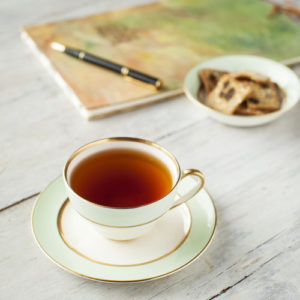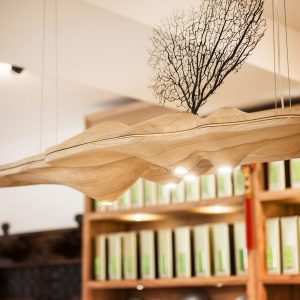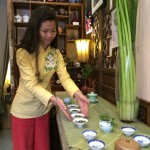The True Chinese “Tea Ceremony”

The meaning of offering tea in ceremonies and celebrations Left: Hong Kong actress Karen Mok and her husband offering tea on their wedding day. Right: Detail from a mural from the tomb of a wealthy man in later 10th century. A man servant is carrying two cups on a tray ready to leave the preparation space to serve elsewhere. He seems to be giving instructions to the woman servant for what is required of in tea preparation, which she is in charge of ( the mural includes a boy servant heating water on a charcoal fire to her immediate left ). How to satisfy the drinkers with what goes into the cup happens in the background. The ceremony is not the preparation itself.
Beth maybe the first to have become a grandparent amongst all my closer friends from high school. It had been difficult to imagine that she got married so early: I was only year two in college. The quiet and humble little girl who was so cooperative in all our drama and magazine productions had been hiding her sweetheart all along.
I still remember the day of her wedding, as I was the photographer of the event. It was the first time I ever took pictures of that nature. The observation I made had much impact on my subsequent exploration of the Chinese heritage. One such projects led to the winning of a Best Young Photographer award by LIFE magazine, although what we shall discuss here goes deeper than what meets the eyes.
The Bridal Dress
The wedding day was busy and intense for all in the families, and the traditional Chinese bridal dress was a big gossip topic amongst the girls. It was expensive, fragile, heavy, and hurtful to kneel in — the richly embroidered, appliqued, and quilted skirt gives deep indentions to the knees, they said. She actually had to kneel in front of the parents for each side of the families for as long as a cup of tea is handed over. I am still puzzled today as to why the fuzz amongst the “sisters” in the crowd. Beth herself did not complain about it after all.
Most people skip the kneeling posture and just offer tea nowadays. One popular reason is that kneeling in front of others is seen as a backward behaviour where one is submissive to an “authoritative” figure (1). This is a great reason if the people of Hong Kong were consistent in this resistant attitude to have been less self-demeaning, less conforming to the powerful and the rich, but that’s another topic.
Pride and Prejudice
- Worshipping of a folk deity on a side street in Hong Kong. People easily bend their knees when asking for favours from deities ( or people in power? ) Photo credit: Independent Media Hong Kong
- Ancestor worship is still a common practice in many parts of China, even in the highly educated population in Hong Kong
- People praying for flavours from a deity in a Daoist temple in Hong Kong. When there is a favour to ask for, there is no problem for the people here to kneel.
People used to kneel not only in front of other people of higher power, but also in front of icons of deities and the ancestors. Some still do today to the latter. In Hong Kong and China, many pay tribute to their ancestors by burning incense and kneeling to kowtow in front of plates marking the names of the deceased in ancestral halls during major rituals to wish for guardianship.
If it is okay to kneel in front of a dead senior family member to ask for a favour, why is it not okay to say a big thank you to the living parents by kneeling down on your wedding day? The concepts to our modern way of thinking is still filled with contradictions and prejudicial taboos.
A very few, however, insist on the tradition of kneeling. The humble act of offering tea to the senior is where there is truly a ceremonial function of tea in the Chinese culture.

This is how the gaiwan is held when offering tea in it. Read more about the etiquette of gaiwan in this article.
The fun of Chinese New Year Tea offering
As with kneeling, the proper offer of tea as a gesture of respect and gratitude is gradually disappearing. When I was small, to offer a cup of sweetened tea to the seniors in the family was the first thing to do on the first day of the New Year. I had to hold the saucer with both hand and say out all the auspicious phrases to grandma and mom and dad while offering the tea. Red packets (the major source of pocket money as a child) were given in return for the simple cup of tea and well wishes.
The idea that a most ordinary daily beverage is used as the vehicle of a key message in an important ritualistic gesture reflects the wisdom of the traditional culture and the wisdom in tea itself.
Why Offer Tea?
The most important things in life are not those that are dramatic, but those that happen daily and repeatedly, much as the moments you spend with the loved ones: preparing a meal together, taking a stroll in the park; driving the kids to school… or your daily work, be it rocket science or window cleaning; they can be common place, routine or even mundane, but they are the most important made-up of one’s life. An offer of a simple cup of tea in important rites is therefore a message in itself: life is not about the highs and lows, but about living everyday well, appreciating the simplest niceties as tea, and turning the ordinary moments into our daily rewards.













